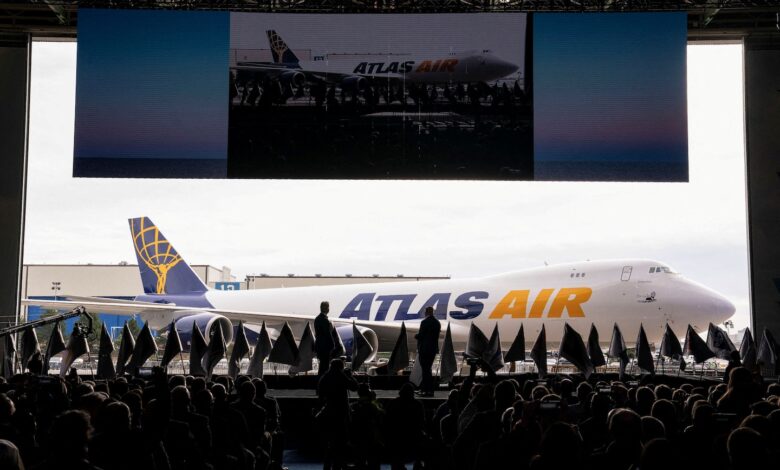Atlas Air flight makes emergency landing after Boeing 747 engine failure

The 747 that left Miami International Airport on Thursday was a cargo flight operated by Atlas Air, whose small crew had been headed to Puerto Rico.
The flight left after 10 p.m., experienced failure of one engine and turned around, according to the carrier and federal regulators. Witness video from Miami, broadcast on the city’s NBC station, showed a plane that appeared to be partially aflame flying through the sky.
It landed, less than an hour after departing, without injuries to the crew. There was no fire when the plane landed, Miami-Dade Fire Rescue told The Washington Post. It was not immediately known what caused the engine malfunction.
“The crew followed all standard procedures and safely returned” to the airport, an Atlas Air spokesperson said in a statement.
The National Transportation Safety Board and the Federal Aviation Administration will investigate the incident, spokespeople told The Post. The FAA reported the hole above the second engine in its incident notice.
Boeing has been under a spotlight since the Jan. 5 blowout accident, which drew public alarm. Some 737-9 Maxes remain grounded pending inspection, and the NTSB and FAA are investigating. What caused that incident, and whether it had to do with the plane’s manufacturing or was an isolated incident, remains unknown.
The FAA has planned an audit of Boeing’s 737-9 Max jet production line and its suppliers. The aerospace giant has pledged its own inspections, while airlines have also indicated plans to scrutinize safety.
Additional incidents have since caught recent public attention: A Boeing 737-800 operated by All Nippon Airways turned around in Japan because of a crack in the windshield on Saturday. On Wednesday, a Boeing set to carry Secretary of State Antony Blinken home from Switzerland was grounded because of a “critical failure” related to an oxygen leak.
The federal investigation of Thursday’s Atlas Air incident should find whether the engine had a mechanical problem or whether an external factor caused the engine to fail, said Daniel Adjekum, an aviation professor at the University of North Dakota.
An object getting into the engine, such as material on the runway or a bird in the air, can cause a failure, he said.
Boeing’s 747-8, which was flown by Atlas Air on Thursday, uses four engines manufactured by GE Aerospace. Boeing said in a statement that the company would support the NTSB’s investigation into the Atlas Air incident, and it referred questions to GE Aerospace.
A GE spokesperson said the supplier was “providing technical assistance” to the federal agencies investigating the incident.
Anthony Brickhouse, an aerospace safety professor at Embry-Riddle Aeronautical University, said emergency landings or mechanical problems aren’t “something that happens regularly.”
“I don’t think an emergency landing or something like that should make the flying public nervous,” he said. “It’s almost human nature to see a few events in aviation happen and to kind of paint the entire industry with the broad brush. I think we need to look at each event independently and not necessarily connect the dots.”
Still, travelers have reported anxiety since the Jan. 5 accident, looking to avoid Boeing Max flights or second-guessing travel plans. That comes after a year with incidents that raised broader airline safety concerns, including near-collisions on U.S. runways.
Anxiety is normal, Adjekum said, but he stressed that robust regulation, training and technology govern flying.
“Normally, when there’s a spectacular event or an almost-catastrophic event, we start getting edgy,” Adjekum said.
“The public is justified to be nervous,” he said. “But then we, as experts in the industry, want to also reassure them.”
He and Brickhouse said flying remains safe.
“Aviation remains the safest mode of transportation out there,” Brickhouse said. “Statistically speaking, if you make it to the airport safely, you’ve actually made it beyond the most risky part of your trip.”





